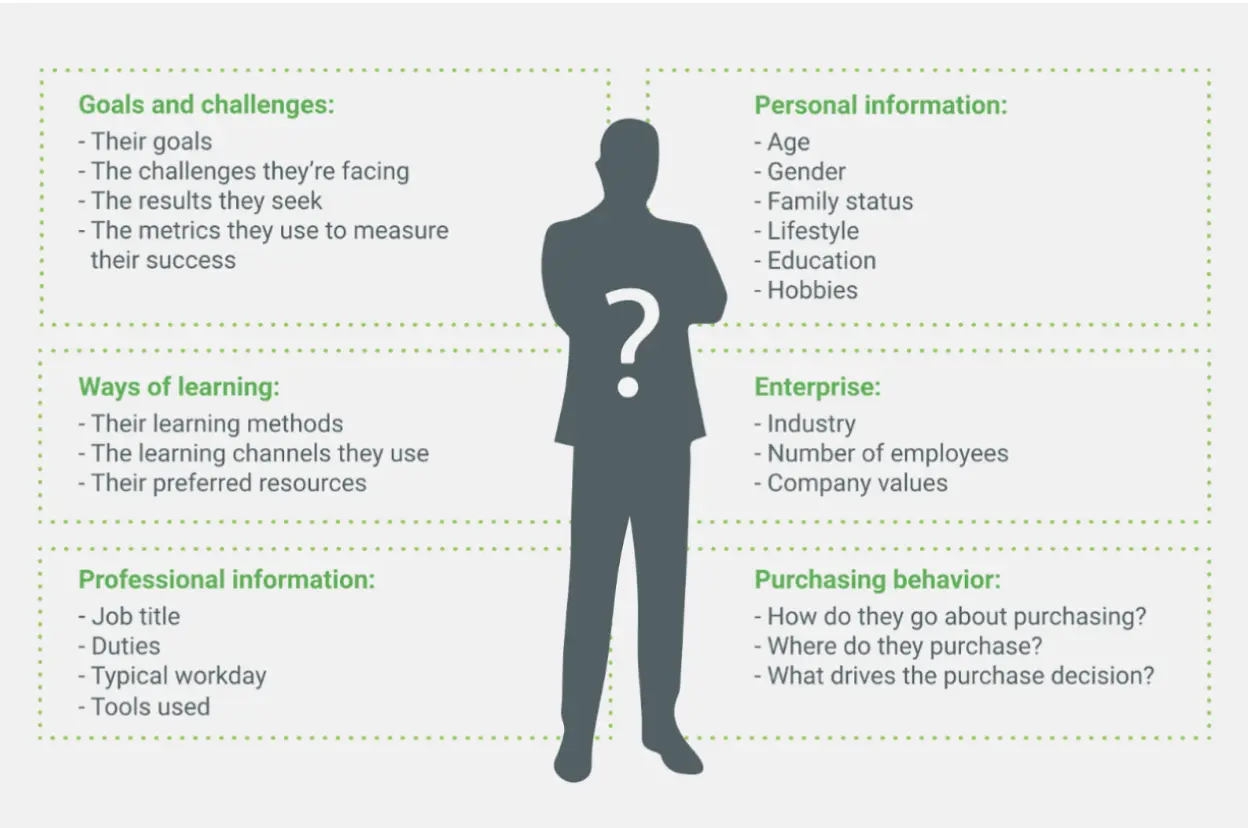The impact social media has had on the marketing world over the last decade is undeniable. It has proven time and time again as a powerful tool for connecting with your audience and spreading brand awareness.
These are all things every marketer should strive for, be it a small business just starting out or a large corporation.
There are 4.48 billion active users of social media, and that number keeps on growing by the year. On top of that, everyone expects companies to be online-ready. Ignoring these facts is like leaving money on the table.
No one can deny that having a social media strategy is crucial. But where to start? Which platform to choose?
6 tips for creating and sculpting your social media campaign to suit your needs:
- Have a set goal
- Research your target audience
- Choose the right platform
- Get to know your competition
- Engage first and frequently
- Don't be pushy

Custom image created in Canva
1. Have a Set Goal
You need to have a clear understanding of why your service or product exists. What is that you want to achieve by delving into the world of social media?
Are you a small company that wants to connect with local followers to grow your brand and its community? Maybe you are a big corporation in need of boosting the loyalty levels of your existing customers.
Simple and defined goals in the long or short term are always preferable.
This, in turn, helps you with your analytics. Having one or more metrics that are easily measurable helps create a clear picture of what your potential bottlenecks are and sort out any flaws in your existing strategy.
For example, tracking critical customer satisfaction metrics will help you enhance the buyers' experience. Satisfied customers become repeat buyers and recommend your offerings to friends and family.
In the next graph, you can see what's the effect of customer satisfaction on customer loyalty.
Source: https://www.b2binternational.com
Don't lose your head and track when you realize that you're catering to millions of people. Yes, there are many potential customers that can turn into leads.
But be realistic! Your marketing strategy goals should always be achievable within your current budget and timeframe. This will create a much clearer picture of your digital environment and help you with future marketing campaigns.
2. Research Your Target Audience
Being just present on social media is not enough. Content needs to be created to attract potential customers and retain current ones.
Creating the correct content with your audience in mind will increase the success rate of any marketing strategy. If not, failure is definitely guaranteed.
Because of these reasons, knowing your target audience is critical knowledge. Don’t forget that these are the people that will repost, like, and comment on your posts.
Knowing everything beginning, from their age, job, location, and more, will help greatly enhance your content creation. Content created with your target demographic in mind is always much more engaging.
 Source: https://www.reliablesoft.net
Source: https://www.reliablesoft.net
Social media is, after all, a product of the digital age. That means that data is easily gathered, categorized, and cataloged.
Make use of tools like Google Analytics or audience insight tools that help you gather much-needed information on your follower base.
Every successful marketer knows that ignoring these factors will put you way behind alternatives and competitors in an ever-changing and evolving digital space.
By now, you should have a clearer picture in your head about your engagement profile. Yes, big data is important on a large scale, but don't forget to create surveys or polls on your followers on a variety of topics.
These can range anything from their interests, and preferred content, to their social media platform of choice.
3. Choose the Right Platform
There are many high-traffic, relevant platforms floating around, like Facebook, Instagram, Pinterest, etc. New ones are emerging and gaining traction every day, like TikTok. The digital landscape is always dynamic, and it never completely peaks.
Don't be fooled into thinking it does. There is no clearly defined cookie-cutter strategy that is applicable to all of them, but you should definitely try and use them to increase your social engagement. Your social media strategy needs always to be updated to stay ahead and on track.
But how to know which platform is the right one for your business? You can, of course, be present at all of them.
It will drastically heighten your marketing team's workload, making them more prone to errors or desync with your goals. Here, picking the right one is key.
Here is a quick overview of the pros and cons of the most used social media sites:
-
Facebook
At first glance, the number one obvious choice. With 2.7 billion daily users worldwide, easily the biggest name in the social media world.
While being the juggernaut that it is, it's a great place to connect with people and build trust. Posting pictures or stories on your business page will keep your audience engaged and informed about your service or product.
It's a great platform for enterprises like news outlets, entertainment, restaurants, travel agencies, etc.
So what's the catch? Facebook limits the reach and visibility of your posts. If you're planning on spreading your business and not just building loyalty, Facebook might not be the right option for you.
Also, believe it or not, because of its social nature, Facebook nowadays attracts a more mature audience. If your target group is younger, consider other alternatives.
-
Instagram
A great place for business, retail, and lead generation.
The proof is in the pudding as Instagram has been growing at a staggering speed of 5% in each quarter, and recently they even implemented a new Instagram algorithm catered towards a younger audience.
Great for spreading brand awareness and building relationships via hashtags and pictures. Easily used to funnel traffic to your website. No wonder nearly one-third of stories viewed on this platform are from businesses.
The downsides are that it works only with image and video formats. Companies and brands that don't have a well-established visual presence may struggle.
It also requires your marketing team to be constantly creative and engaging with its content that needs to be posted at least daily.
-
X (formerly Twitter)
X (formerly known as Twitter) is a great service for sharing topics, opinions, and live updates. A very dynamic and fast-paced platform relying on quick communication.
It's a great tool for keeping your audience updated with your business practices as well as building a sense of community and public relations.
Its flaws begin to show if you want to spread awareness about your service. While it makes use of hashtags and reposts to increase reach, Tweets usually have a very short lifespan. Posts are limited to only 280 characters or less.
-
LinkedIn
A professional social media platform. Often looked at as the Facebook of the business world. Excellent platform for B2B enterprises that want to connect with their target audience.
It supports image and text-based content and is mainly used for gaining knowledge of specific fields.
It can be used to great effect if it aligns with your business practices but has the downside of not having as much traffic, and people don’t post as often as on other platforms.
YouTube: The main and go-to website for video content. It does not require any registration or log in to use this platform. Video is a more easily engageable and digestible format than text.
This has resulted in YouTube becoming the second most popular search engine after Google. It has a variety of channels on nearly every topic, from education, business, fashion, news, etc.
Therefore many types of businesses can greatly profit from content generated as well as paid ads on videos.
While YouTube does not require you to post frequently as other platforms, quality is important and makes a big difference. If you’re willing to invest in video content, don’t skip this opportunity.
4. Get to Know Your Competition
Competitor research is a valuable method for gathering valuable insight or even adopting new strategies and ideas.
Benchmarking your results against rival companies or bigger dogs in the industry will let you spot opportunities and eliminate bad practices in your existing strategy.
Companies put money where their future ambitions and goals are. Identifying those will give you much-needed information.
Observe what platform is most commonly used by your competitor, what kind of content they are posting, and how frequently.
Are they catering to a younger audience? Is it oriented towards a more male or female audience?
5. Engage First and Frequently
A logical step, but not always obvious. Depending on your desired platform, tailor the amount of content generated.
For example, Twitter, due to its fast pace and large content generation, will require you to post up to 3 tweets daily, while YouTube will require updates less frequently.
Others like Facebook will reward you for posting daily so that their algorithm will funnel traffic to your page organically.
Source: https://fanbooster.com/
6. Don't Be Pushy
People are tired of seeing adverts on the internet, especially on social media. Don't overload your social media pages with sales and marketing. Brute force in this situation is not your friend.
Instead, try to establish a connection with your audience. Post stories that trigger an emotional response or even a calm and welcoming atmosphere. That's what these platforms are there for, building relationships.
Educate your audience gradually, and then ask for a sale. Heavy sales language and pushy ads will get ignored or even blocked.
Conclusion
Leading a successful social media campaign can be difficult and stressful. And you are not alone in the struggle.
Knowing your brand and audience will help you identify your goals. From there, picking the right social media platform and applying these tips will definitely put your marketing campaign on the right track.
Remember, it's all about communication and appreciating your customers and their time. Your brand voice should reflect that in every post, image, or emoji while avoiding cornering them with useless marketing talk.
Because just like in real life, nourishing a relationship takes time and dedication, which will blossom into an everlasting bond.
Author Bio
Daniel Bishop started off his career in digital marketing by working for a few local companies. After a year or two of learning different aspects of the job, he moved on and worked for DesignRush as a content advisor.
Right now, he's working for SocialTradia as an assistant editor and marketing consultant. Other than that, he enjoys good coffee and Otis Redding. Follow Daniel on Twitter and LinkedIn.


